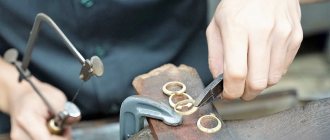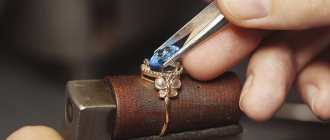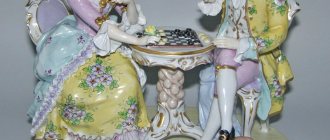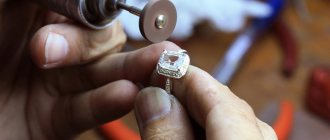Photo source alexeyzhilkin/freepik
Products made of precious metals and stones have always played a special role in human society. Mainly due to its decorative properties and value as jewelry. In addition, gold and precious stones have always been an indicator of the high social status and nobility of their bearer.
Nowadays, this is no longer so relevant, but oddly enough, jewelry does not lose either in price or in popularity. Which naturally leads to high demand for those who create them - jewelers.
What do jewelers do?
The profession of a jeweler originated in the era of Ancient Egypt and Ancient Greece. At that time, the craft had many cult and religious motives, since gold and jewelry always played an important role in the performance of rituals.
Gradually, with changes in the economic structure and outlook, the cult component of the craft moved to the fore. Nowadays, jewelry carries exclusively aesthetic qualities and serves as a means of self-expression for its wearers.
Of course, technological development also leaves its mark on the profession. Jewelers still create jewelry primarily by hand, but they can now invent and design it using a 3D editor, and in production they use a variety of mechanical devices.
The profession of a jeweler is complex and multifaceted. There are a great variety of techniques for making jewelry. Therefore, narrow specializations emerged on their own:
- jeweler-engraver;
- jeweler-mounter;
- jeweler-polisher;
- jeweler-setter;
- jeweler-foundry;
- jeweler-fashion designer;
- jeweler-enamelier;
- jeweler-designer.
Description
Making jewelry is a delicate and very complex job. The master must master a huge number of different techniques, techniques and, moreover, have a subtle artistic taste. The manufacture of products usually includes several processes at once: forging, casting, embossing, graining, polishing, embossing, engraving. There are a huge number of jewelry techniques, and the master must be fluent in each of them. The profession is complex and multifaceted, so there are several specialties in it:
- Bracelet.
- Chain maker.
- Engraver. She creates unique jewelry to order, applying drawings or ornaments to them.
- Fixer. Makes jewelry with inserts, makes wax models.
- Filigree maker. Master of the openwork or soldered pattern technique.
- Mounter. Assembles products from scattered parts and performs final processing.
All of these specialties involve delicate, meticulous work that requires technical skill, talent, and skill with tools.
Responsibilities of a jeweler
Photo source: master1305/freepik
The list of responsibilities of a jeweler should include:
- creating sketches and compositions;
- processing of stones and metals;
- work on blanks;
- various techniques for assembling jewelry depending on its type;
- creating ornaments or engravings on a finished product;
- checking compliance with quality standards.
In order to perform these duties, a specialist must know:
- classification of stones and metals used, their properties and principles of working with them;
- principles for creating sketches and models of future products;
- rules for rejecting materials and products.
Interesting Facts
Jewelry craftsmanship has a rich history, during which many interesting events took place:
- A necklace made of mollusk shells is considered the oldest piece of jewelry : according to experts, the age of the product is at least 115 thousand years.
- The founder of the Cartier brand is the first master who used platinum to create jewelry. Previously, coins were mainly made from metal.
- Working with precious materials requires calmness and scrupulousness from craftsmen, therefore, before entering educational institutions, applicants are required to undergo examination by a narcologist and psychologist.
- The profession of a jeweler is considered hereditary , which is passed on from generation to generation - usually the fate of a child in such families is already predetermined from childhood.
- The most valuable jewelry is considered to be those found on the ocean floor after the Titanic disaster. The collection includes: necklaces, pins, brooches, rings and, of course, the most important thing – the “Heart of the Ocean” necklace, which can be seen on the heroine of James Cameron’s film.
- Due to its plasticity, gold quickly loses its shape, so it is never used in its pure form, but is alloyed with other metals.
- The dark blue Wittelsbach diamond is the most expensive in the world - its cost is approximately $80 million.
Jewelry craftsmanship is a real art. Despite the high work requirements and existing disadvantages, this profession remains one of the most in demand, creative and highly paid in the world.
You will learn more about the profession of a jeweler by watching the video :
Requirements for a jeweler
The work of a jeweler requires increased concentration, focus and precision. Therefore, good vision, a keen eye, and developed muscle motor skills are extremely important in the profession.
The presence of the following diseases can become an obstacle to realization as a jeweler:
- visual impairment;
- joint diseases;
- problems with the musculoskeletal system;
- nervous disorders.
Where to study
A higher education is not required to work as a jeweler. You can master a craft at a college (technical school, school) or even through courses. However, if you want to get a diploma in your specialty at a university, you also have this opportunity. Examples of educational institutions:
- Moscow State Art and Industry Academy named after. S. G. Stroganova;
- St. Petersburg State University of Technology and Design;
- Kazan College of Folk Arts and Crafts;
- Ufa College of Arts and Humanities;
- International Jewelry School (St. Petersburg).
Place of work and working conditions
A jeweler has only two employment options - a workshop or a jewelry factory. In the first case, we are talking about a small enterprise that produces unique, designer jewelry. Although the main activity of such campaigns will still be the repair of finished products.
The second option offers mass production based on already approved sketches. But employees of such plants and factories do not have the opportunity to fully unleash their creative potential, because they have a very limited range of tasks.
At the same time, regardless of the place of work, the jeweler’s workplace must be well lit and have all the necessary tools and equipment for work.
Tips and tricks for employment
Where can a jeweler work:
- in a private workshop where jewelry is made, repaired, cleaned, and polished;
- in a plant or factory that produces jewelry on an industrial scale;
- in a pawnshop, jewelry store, office, where the services of an expert who can fairly assess the authenticity and cost of jewelry are needed.
Vacancies for jewelers rarely appear on HR portals. You can independently find the contacts of workshops and factories, call and ask if workers are needed. University graduates should contact the career center at their educational institution or employment center.
Where can I learn to be a jeweler?
There are several ways to master a profession. Firstly, enter a secondary specialized or higher educational institution, where one of the directions is presented:
- "Jewelry";
- “Decorative and applied arts and folk crafts”;
- "Jeweler".
Thanks to this, you can receive basic or advanced training in the profile of interest. And regardless of the type of educational institution, students receive the necessary theoretical basis on the types of metals and stones, their properties, and processing methods. In addition, the educational process also includes practical classes in which future jewelers hone their skills in creating various jewelry.
Secondly, just like centuries ago, in the jewelry business the approach of mastering the profession directly in practice has been developed and is actively used. Therefore, those who wish can get jobs either as assistants to experienced jewelry craftsmen, or as trainees at the relevant factories. Most often, the most talented and capable will find official employment.
Professional skills and personal qualities
This profession requires a number of professional skills, without which it is impossible to become a real specialist. Of these, the following are particularly noteworthy:
- Knowledge of the types of jewelry and the characteristics of their components.
- Ability to understand the types of metals and stones, knowledge of their properties and characteristics.
- Knowledge of technical and artistic requirements for the manufacture of products.
- Proficiency with specialized tools.
- Having developed imagination and artistic abilities.
- Ability to draw by hand and in computer graphics programs.
- Knowledge of mechanical techniques: casting, stamping, rolling and others.
- Mastery of technical techniques: engraving, forging, embossing, shotting, etching, inlay, etc.
Since the work of a jeweler often involves the production of miniature elements, in addition to professional skills, the master will need some personal qualities. A specialist must have developed fine motor skills, a good eye, excellent color perception, accuracy, perseverance, and the ability to concentrate. It is important to have artistic taste, creativity, a rich imagination, as well as a desire for constant self-development.
Where to get an education
You can get a profession in specialized technical schools or colleges, as well as in universities. In our country, jewelry art is taught at the Faculty of Geology or in the specialization “artistic processing of metals.” In Russian educational institutions the main emphasis is on craft skills. Students are taught the basics of stone and metal processing, learn to estimate the cost of materials, and determine their origin. Students also try hands-on processing of metals and stones.
If you want to engage not only in the manufacture and repair of other people’s orders, but also in the creation of designer jewelry, you should think about getting an education in Europe. In European educational institutions, students have the opportunity to fully reveal their talent and show their imagination, gain design skills, and also collaborate with leading fashion houses. At the end of the training, students receive a personal portfolio with their own line of jewelry.
It should be noted that the self-learning method is practically excluded. Since it is difficult to obtain a theoretical basis due to the small amount of freely available professional literature, and it is impossible to hone professional skills without special equipment, tools and materials.
Prospects for the profession
Specialization opens up great opportunities for young masters. As a rule, newcomers to this business begin their careers by working in jewelry factories and factories as junior specialists. Here they hone their skills, improve their skills, and acquire new knowledge. For each stage of development, the master is assigned a certain rank, the highest of which is VII. Such masters are in great demand, which makes it possible to easily find a higher-paying job or move up the career ladder - to become the head of a department or even the director of an enterprise.
After receiving the rank, you can try to start your own business. For example, open your own workshop for making and repairing jewelry, or even go deeper into the development of designer products. This opens up new prospects and opportunities for the master: participation in exhibitions, developing his own line of jewelry, receiving individual orders.
Rank of the jeweler profession
Photo source: freepik
The skill and professionalism of a jeweler is reflected in the level of qualification assigned to him.
Jeweler 1st category
Engaged exclusively in preparatory work.
Jeweler 2nd category
Works with simple products made of various metals.
Jeweler 3rd category
Can create products that have an average level of complexity.
Jeweler 4th category
Has the necessary skills to work with complex products, as well as to carry out restoration work.
Jeweler 5th category
He creates products based on his own designs and can restore antique jewelry made from precious metals.
Jeweler 6th category
He deals with unique products that have saw-cut designs, and can also create ornamental designs.
All specialists who create jewelry taking into account cultural heritage and traditions are called 7th category jewelers-fashion designers
.
Pros and cons of the profession
Before becoming a jeweler, you need to weigh the pros and cons. This profession has its advantages and disadvantages , which will help you make the final decision.
pros
The main advantages of the jewelry profession:
- Stability . Jewelry will always be in demand, regardless of the fashion and economic situation in the country.
- Wage . The average salary for jewelers is 35-45 thousand rubles. per month.
- Convenient work schedule . Most craftsmen work as freelancers or for hire - this means a flexible schedule and arbitrary time workload.
- Career prospects . Thanks to designer products, craftsmen always receive well-paid individual orders and a reputation.
Minuses
Main disadvantages:
- It is difficult to find a good professional mentor : as a rule, jewelers try to pass the business on by inheritance.
- Regular work with small parts and processing products puts a lot of strain on your eyesight , resulting in significant deterioration of your vision.
- A sedentary lifestyle worsens health.
- Equipment for creating jewelry is expensive : professional equipment is estimated at approximately several thousand dollars.
- A jeweler appraising expensive items should never make a mistake , otherwise he will lose his reputation and incur large expenses.
- Careless handling of tools may result in personal injury .
- It is not always possible to meet the customer's expectations .
- The use of chemicals in work often causes burns .
Jeweler workflow
To become a jeweler you need good eyesight and patience.
The profession of a jeweler is considered extremely profitable and highly paid - precious jewelry and luxury items will always be in fashion, despite economic turmoil. However, this job is not for everyone. Firstly, in order to become a jeweler, imagination alone is not enough; knowledge and understanding of chemistry and mathematics are required. Secondly, performing complex work requires good vision.
Jeweler at work. Photo: RIA Novosti
The patrons of Orthodox jewelers are Cosmas and Domian, and those of Catholic jewelers are Dunstan.
In the Orthodox faith, the patrons of handicrafts, which include jewelers, are Cosmas and Domian. Their memorial days are celebrated on July 14 and November 14. The patron saint of Catholic jewelers is Dunstan. There is a legend that the devil came to the saint’s forge and asked him to shoe him. The blacksmith recognized the evil one and therefore shoed the devil too painfully that he had to beg for mercy. Dunstan freed the uninvited guest, but on the condition that he would never cross the threshold of the place where there was a horseshoe.










